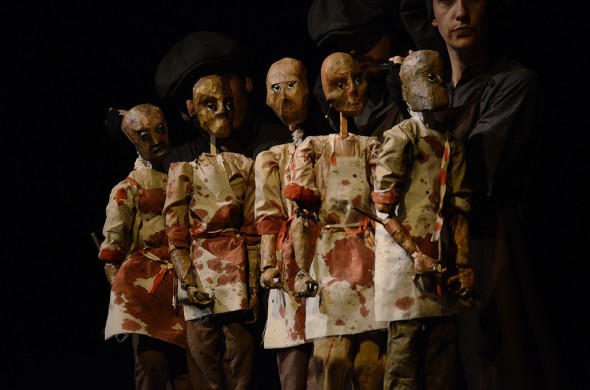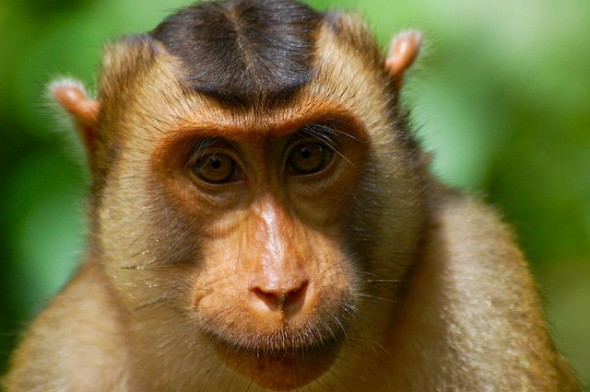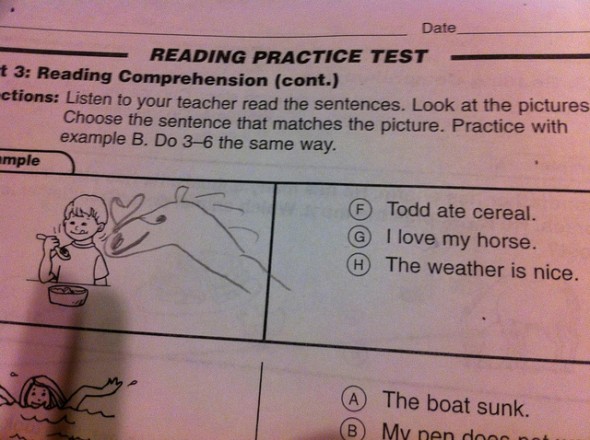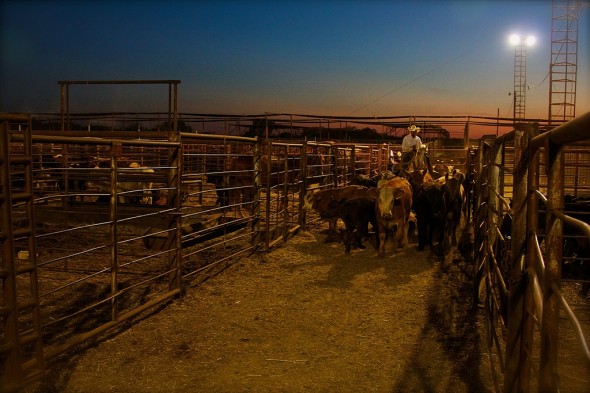Cathy N. Davidson’s new book, Now You See it: How the Brain Science of Attention Will Transform thw Way We Live, Work, and Learn (see my review on Open Parenthesis), takes one of its core inspirations from an experiment by Daniel Simons and Christopher Chabris, which you may have seen.
In the experiment, users are told to count the number of passes made by either the team wearing white shirts or the team wearing black. The experiment, however, isn’t really about the counting. Instead, the experiment is about selective attention, and how our focus on one specific task (counting) makes it impossible for us to see another phenomenon (the female student in the gorilla suit who walks into the center of the frame and strolls causally out). As Davidson puts it in the Introduction to the book:
He’d set us up, trapping us in our own attention blindness, priming us for his lecture. . . . By concentrating so hard on the confusing counting task, we had managed to miss the main event: the gorilla in the midst. (pg. 2)
The point of the anecdote, for Davidson, isn’t so much that most people missed the gorilla in their attempt to count accurately, but that she saw the gorilla (largely because she made no attempt to count accurately, knowing that kind of task was not well suited to her). Rather than reading the event as a failure of attention, Davidson uses it (here and throughout the book) to represent the positive opportunities of collaboration through difference:
If we see selectively, but we don’t all select the same things to see, that also means we don’t all miss the same things. If some of us can accurately count basketballs in a confusing situation and some can see the gorilla, we can pool our insights and together see the whole picture. That’s significant. The gorilla experiment isn’t just a lesson in brain biology but a plan for thriving in a complicated world.
Davidson uses this central principle to drive a far-ranging discussion: how humans learn (more brain science), how institutional education tries to teach (via rote memorization and standardized testing of a very specific kind), how modern workplaces are transforming based on the internet and globalization, and how collaboration through difference represents a way of adjusting education to better match the realities of the new world of work. Our modes of education need to be changed in order to produce the kind of workers needed in the 21st century: capable of complex, cross-cultural understanding, multitasking at a high level, and collaborating through difference on cooperative projects at large scale. (cf. the Internet itself, linux, wikipedia, open source, etc.).
Reading Now You See It as a vegan, though, I couldn’t help but notice that my own attention also often goes to places the author does not intend. Being vegan in a world of carnists means constantly seeing and recognizing animals as sentient beings with interests we are ethically bound to respect. Being vegan means seeing the gorilla in an entirely different way than Davidson intends the metaphor: seeing as fellow beings animals that others see as food or raw materials.
In chapter 2, “Leaning Ourselves,” for example, Davidson describes the scientific discovery of mirror neurons:
They placed electrodes in the ventral premotor cortex of macaque monkeys to see how their neurons were firing when they were picking up food and then eating. By doing so, the neurophysiologists were able to record the activity of single neurons when the monkeys were feeding themselves. That, alone, was news.
Then, one day, something really interesting happened. The Parma scientists began to notice that neurons were firing in exactly the same pattern whether the monkey was picking up a piece of food and eating it or was watching a human or another monkey pick up a piece of food to eat. (p53)
Of course the point Davidson is trying to make is about how mirror neurons work in primates (ie, in humans and macaque monkeys) and not about the monkeys themselves. But reading as a vegan, I can’t read that passage without stopping short on the line “placed electrodes in the ventral premotor cortex,” interrupted by visions of the horrors of vivisection and institutionalized animal abuse flooding my peripheral consciousness. (Cue Peter Gabriel’s “Shock the Monkey” video in your own peripheral consciousness).
In Simons and Chabris’ experiment, the female student in the gorilla suit walks undetected through the basketball passing crowd, by observers too focused on counting to notice. In Davidson’s retelling of the Parma experiments, the unnamed macaque monkeys with their implanted (“placed?”) electrodes, bred for scientific experiments, live their entire lives in cages but go essentially unremarked, serving simply as a data set because her attention is elsewhere.
Now, I’ve no idea how Giacomo Rizzolatti and his fellow scientists at the University of Parma treat the animals on which they perform experiments (though I’ve seen enough video of animal experiments to have a good guess). I’ve no idea what Davidson thinks about the ethics of animal experimentation (though her discussion of brain science suggests that a minimum she finds it acceptable). But it certainly seems to me that this time she’s missed the gorilla in the midst.
One of the largely positive role models in the book is Inez Davidson, the mother of Davidson’s first husband. Inez Davidson taught in a one room schoolhouse in the Canadian Rockies:
She rode half-wild horses to school each morning, alone in the dark and cold through grizzly country, “putting miles on them,” as she would say, before they could be sold to local ranchers as well-trained working horses. (p.82)
Inez is described (romanticized?) as a kind of prototypical cowgirl but also a budding environmentalist and prescient supporter of physical education for kids:
She was concerned about both food additives and contaminants in the air and drinking water even in cattle country, where the water supply was tainted by runoff from oil and smelting plants far away. She was also shocked at how parents were driving to school instead of having them walk or ride horses in; these were forms of physical exercise she believed were important to kids’ health, well-being, and concentration in the classroom. (p.83)
Confronted with Rodney, a student other teachers have written off as “slow,” Inez Davidson teaches him to use his hands like an abacus, becoming a kind of savant with arithmetic:
He could put his hands under the table and, without anyone seeing, do “rapid calculation” instantly. He did so as a kid, acing math tests, and he did so as an adult, gaining a reputation for uncanny speed and accuracy in the brawny, take-no-prisoners arena of the cattle auctions. Rodney was no one’s fool. (p.83)
Again, Davidson’s point is meant to be about different learning styles. Inez Davidson saw that Rodney’s learning style was better served by a different teaching method, adapted, and made success where others had seen only failure. Take too narrow a perspective on what success looks like – standardized, end-of-grade testing in the public schools for example – and you alienate significant parts of the student population for whom that style of learning is ineffective or impossible.
But I can’t help reading it without wondering about the cattle auctions, and the half-wild horses. Would the passage have the same resonance if it were a story of an antebellum schoolteacher whose student went on to make a name for himself at the slave auctions? I realize to some readers that sounds like hyperbole, or risks invoking Godwin’s law, but buying and selling slaves was once common practice too.
Later, in a section on the origins of letter grades, Davidson writes:
The first school to adopt a system of assigning letter grades was Mount Holyoke in 1897, and from there the practice was adopted in other colleges and universities as well as in secondary schools. A few years later, the American Meat Packers Association thought it was so convenient they adopted the system for the quality or grades, as they called it, of meats*. (112)
The asterisk points to a footnote – the only footnote in the whole book, the rest being all endnotes and mostly references:
It’s interesting that if you dig at all into the U.S. Department of Agrilculture literature you find that even grading slabs of sirloin or chuck is a less clear-cut matter than meets the eye. There are uniform standards of meat quality that are debated regularly and changed occasionally. A truth-in-labeling law had to be instituted to guard against misrepresentation of what the grade even means. If it’s that tough grading beef, imagine what’s behind testing our kids.
Why is it “interesting”? (I used to write this in the margin of my student’s essays, as “it’s interesting that” is often a construction that buries the lede, as it were – better to start the sentence with what makes it interesting, or what point you’re trying to make by identifying some kind of contradiction or complication). It’s interesting, presumably, because the assumption would be that grading beef is simple and straightforward: nothing to worry about in the meat supply. Discovering that the “uniform standards” actually get debated, challenged, and changed occasionally suggests that maybe it isn’t all that simple. Never mind the serious and substantial concerns even among omnivores and carnists about the dangerous levels of e.coli, salmonella and related bacteria in the U.S. Food supply, or mad cow disease, or the over-use of antibiotics on livestock leading to the development of antibiotic resistant strains, or the fundamental inability of inspectors to actually regulate the industry. Nothing to see here, just more proof that grades are artificially concealing complexity by oversimplifying the task of evaluating students or the carcasses of slaughtered animals.

Trouble Puppet's production of The Jungle based on Upton Sinclair's novel (Photo by Stephen Pruitt, cc-by-nc-sa license)
Ultimately Davidson concludes that:
If I were to distill one simple lesson from all the science and all the stories in this book, it would be that with the right practice and the right tools, we can see what we’ve been missing. . . . From infancy on, we are learning what to pay attention to, what to value, what is important, what counts. Whether on the largest level of our institutions or the most immediate level of concentrating on the task before us, whether in the classroom or at work or in our sense of ourselves as human beings, what we value and what we pay attention to can blind us to everything else we could be seeing. (p.291)
Shifting one’s perspective to embrace veganism often means becoming suddenly and painfully aware of things you previously managed to shut from consciousness if not from view. It is important, however, to keep that perspective: to keep pointing to the gorilla in the midst, the macaque in the lab, or the cattle being prepped for auction. It matters because what we can bring to the “collaboration through difference” opportunity is a sustained ethic of paying purposeful attention to animals otherwise considered merely as raw materials.


